Study on chemical constituents of the leaves of sterculia foetida linn
Sterculia foetida Linn. (Sterculiaceae) is grown in tropical areas around the world
(Chi, 2002; Peng et al., 2009). The latex of this species can be used as herbal drinks and
beverages (Vo, 2002). The S. foetida extracts showed antidiabetic, anticancer, antibacterial,
anti-inflammatory and analgesic activities (Peng et al., 2009). Flavonoids, triterpenoids,
steroids and fatty acids were addressed (Peng et al., 2009; Mujumdar et al., 2000;
Anjaneyulu et al., 1981, Kale et al., 2011). Our previous phytochemical studies on this
species reported some oleanane-type triterpenoids, quercetin derivatives and phenolic
compounds (Pham et al., 2018; Pham et al., 2019). This paper presented the isolation and
structural elucidation of three compounds, including hesperidin (1), kaempferol (2) and
ursolic acid (3) from S. foetida leaves collected in Binh Thuan Province, Vietnam.
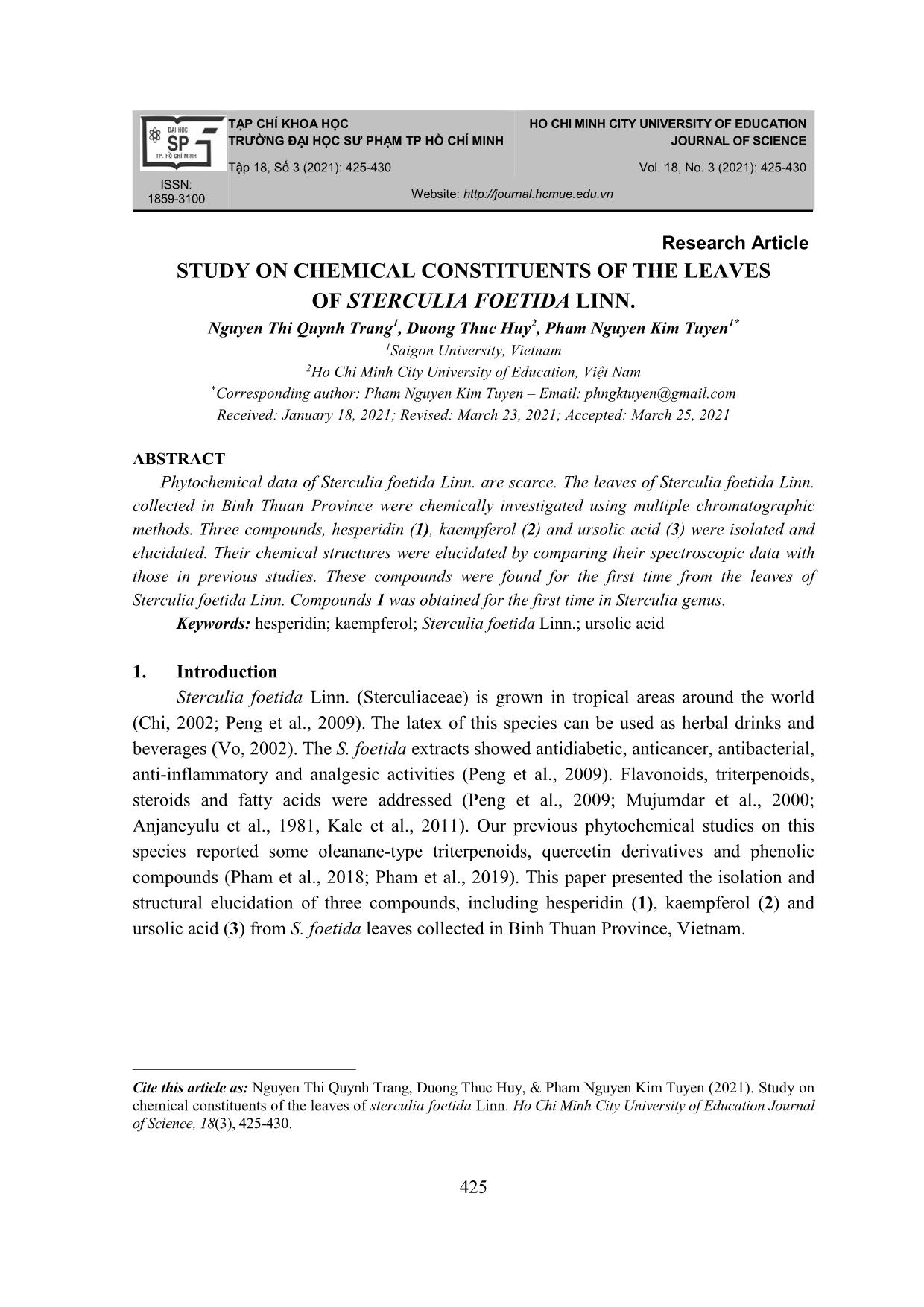
Trang 1
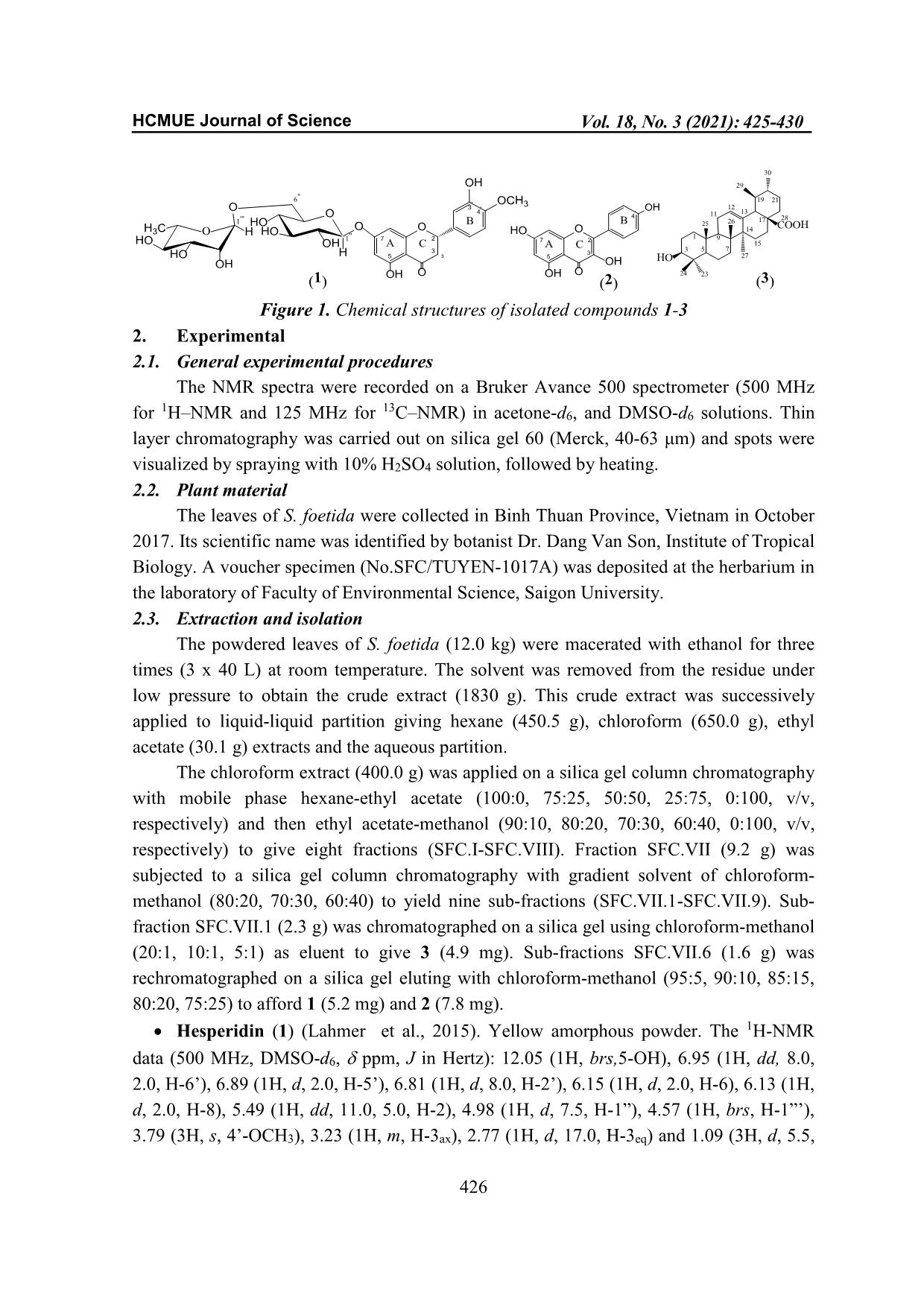
Trang 2
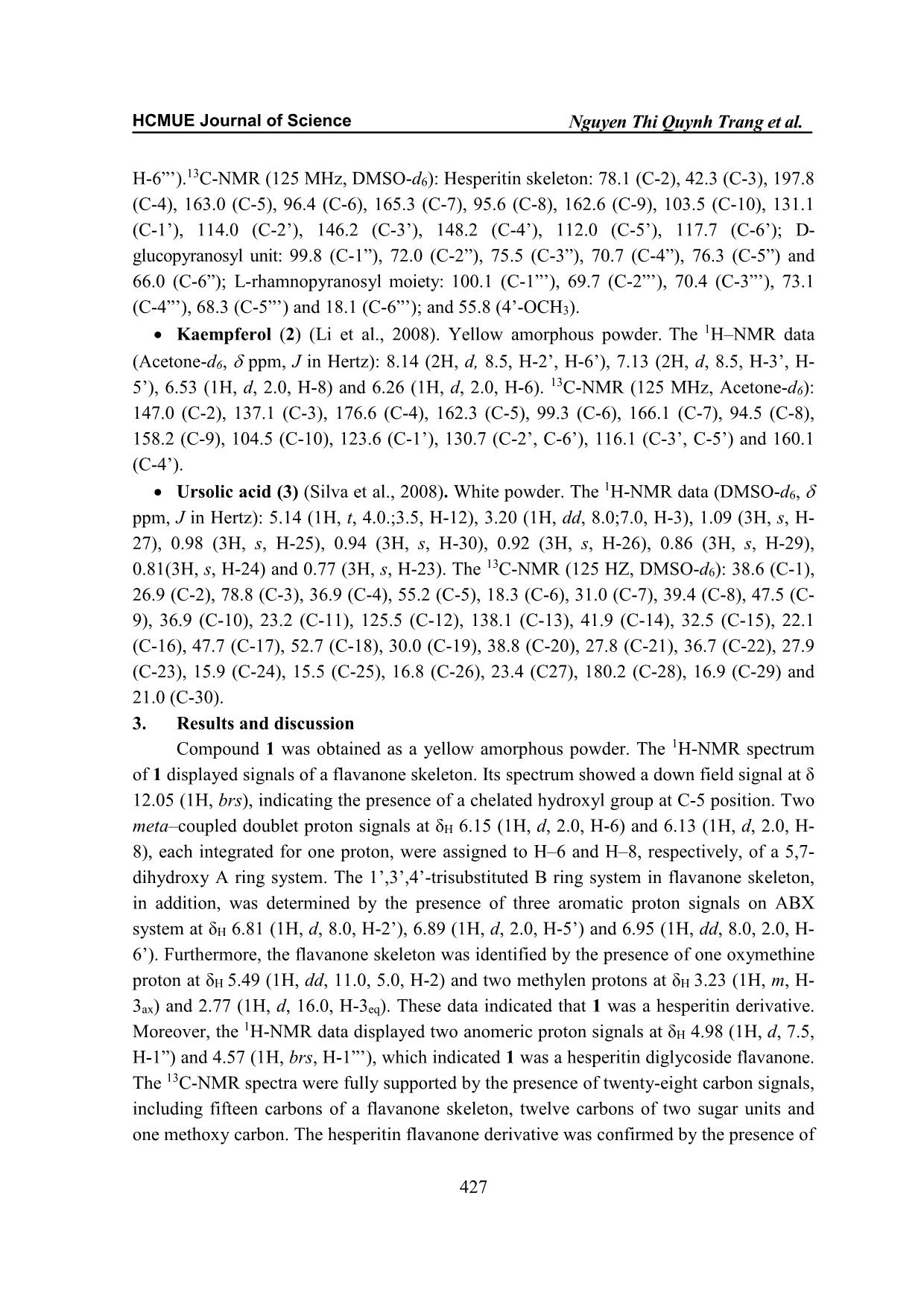
Trang 3
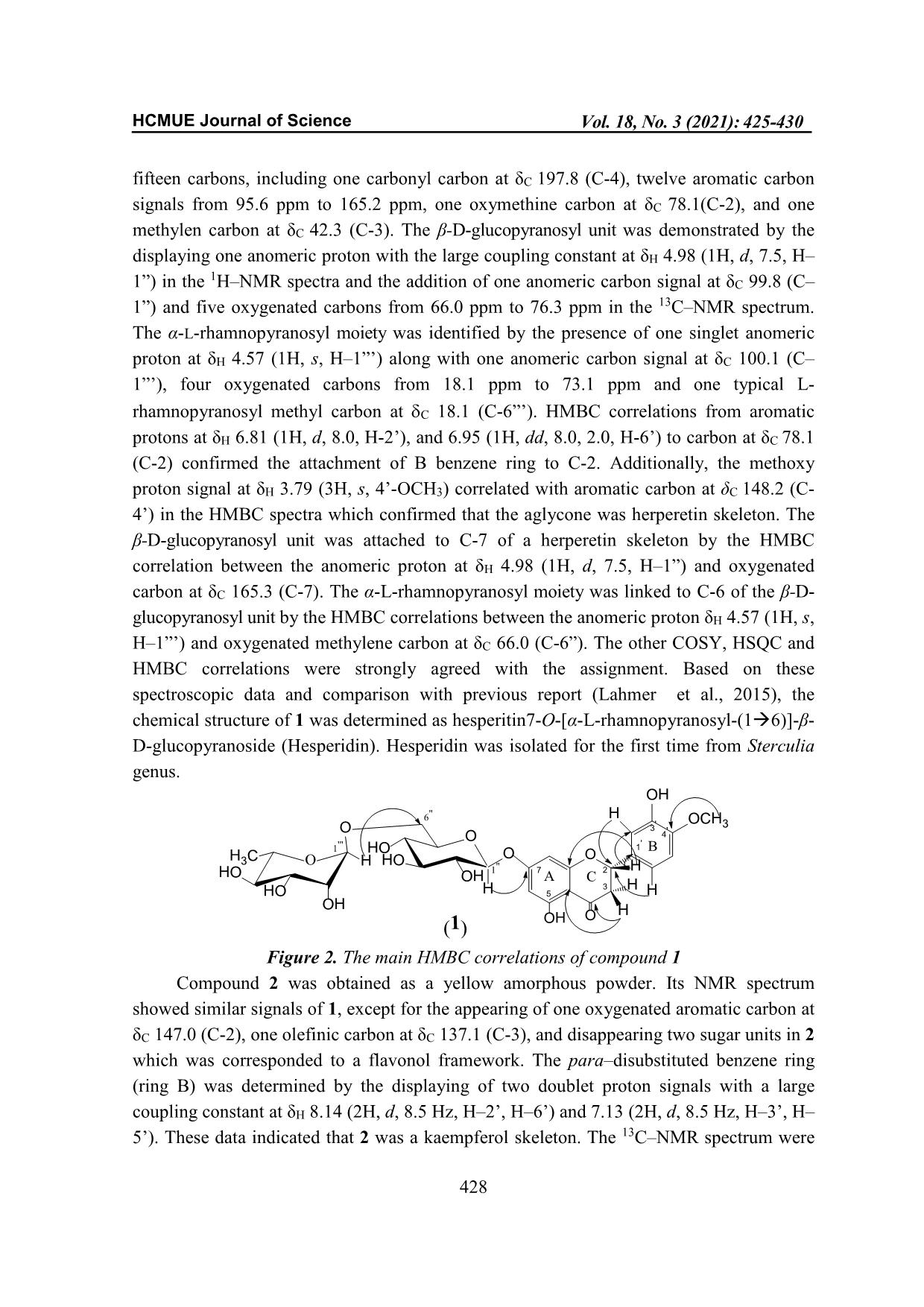
Trang 4

Trang 5
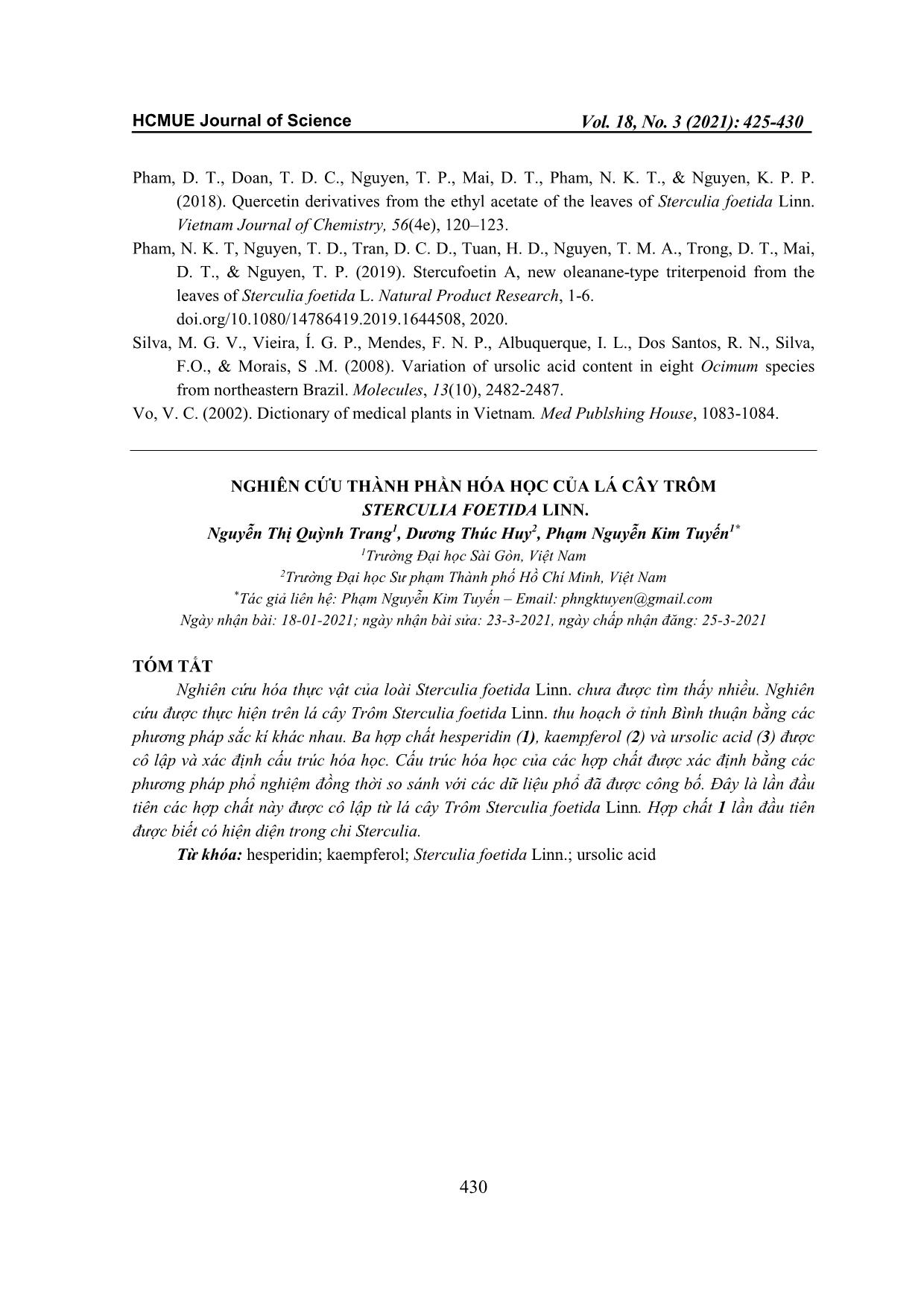
Trang 6
Tóm tắt nội dung tài liệu: Study on chemical constituents of the leaves of sterculia foetida linn
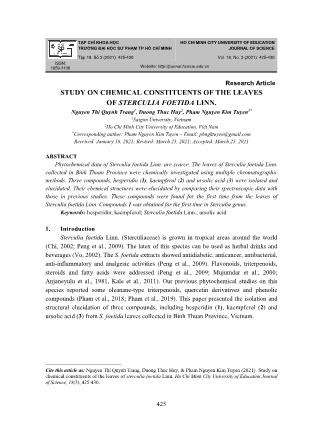
TẠP CHÍ KHOA HỌC HO CHI MINH CITY UNIVERSITY OF EDUCATION TRƯỜNG ĐẠI HỌC SƯ PHẠM TP HỒ CHÍ MINH JOURNAL OF SCIENCE Tập 18, Số 3 (2021): 425-430 Vol. 18, No. 3 (2021): 425-430 ISSN: 1859-3100 Website: Research Article* STUDY ON CHEMICAL CONSTITUENTS OF THE LEAVES OF STERCULIA FOETIDA LINN. Nguyen Thi Quynh Trang1, Duong Thuc Huy2, Pham Nguyen Kim Tuyen1* 1Saigon University, Vietnam 2Ho Chi Minh City University of Education, Việt Nam *Corresponding author: Pham Nguyen Kim Tuyen – Email: phngktuyen@gmail.com Received: January 18, 2021; Revised: March 23, 2021; Accepted: March 25, 2021 ABSTRACT Phytochemical data of Sterculia foetida Linn. are scarce. The leaves of Sterculia foetida Linn. collected in Binh Thuan Province were chemically investigated using multiple chromatographic methods. Three compounds, hesperidin (1), kaempferol (2) and ursolic acid (3) were isolated and elucidated. Their chemical structures were elucidated by comparing their spectroscopic data with those in previous studies. These compounds were found for the first time from the leaves of Sterculia foetida Linn. Compounds 1 was obtained for the first time in Sterculia genus. Keywords: hesperidin; kaempferol; Sterculia foetida Linn.; ursolic acid 1. Introduction Sterculia foetida Linn. (Sterculiaceae) is grown in tropical areas around the world (Chi, 2002; Peng et al., 2009). The latex of this species can be used as herbal drinks and beverages (Vo, 2002). The S. foetida extracts showed antidiabetic, anticancer, antibacterial, anti-inflammatory and analgesic activities (Peng et al., 2009). Flavonoids, triterpenoids, steroids and fatty acids were addressed (Peng et al., 2009; Mujumdar et al., 2000; Anjaneyulu et al., 1981, Kale et al., 2011). Our previous phytochemical studies on this species reported some oleanane-type triterpenoids, quercetin derivatives and phenolic compounds (Pham et al., 2018; Pham et al., 2019). This paper presented the isolation and structural elucidation of three compounds, including hesperidin (1), kaempferol (2) and ursolic acid (3) from S. foetida leaves collected in Binh Thuan Province, Vietnam. Cite this article as: Nguyen Thi Quynh Trang, Duong Thuc Huy, & Pham Nguyen Kim Tuyen (2021). Study on chemical constituents of the leaves of sterculia foetida Linn. Ho Chi Minh City University of Education Journal of Science, 18(3), 425-430. 425 HCMUE Journal of Science Vol. 18, No. 3 (2021): 425-430 30 OH 29 6" OCH 19 21 3' 3 12 O 4' OH 13 4' 11 '" O 17 28 1 HO B B 25 26 O 14 COOH H3C O H HO O HO O 1" 7 2 1 9 HO A 7 2 15 OH C A C 5 7 3 3 3 HO H 5 3 5 HO 27 OH OH O O 24 23 1 OH OH 2 3 ( ) ( ) ( ) Figure 1. Chemical structures of isolated compounds 1-3 2. Experimental 2.1. General experimental procedures The NMR spectra were recorded on a Bruker Avance 500 spectrometer (500 MHz 1 13 for H–NMR and 125 MHz for C–NMR) in acetone-d6, and DMSO-d6 solutions. Thin layer chromatography was carried out on silica gel 60 (Merck, 40-63 μm) and spots were visualized by spraying with 10% H2SO4 solution, followed by heating. 2.2. Plant material The leaves of S. foetida were collected in Binh Thuan Province, Vietnam in October 2017. Its scientific name was identified by botanist Dr. Dang Van Son, Institute of Tropical Biology. A voucher specimen (No.SFC/TUYEN-1017A) was deposited at the herbarium in the laboratory of Faculty of Environmental Science, Saigon University. 2.3. Extraction and isolation The powdered leaves of S. foetida (12.0 kg) were macerated with ethanol for three times (3 x 40 L) at room temperature. The solvent was removed from the residue under low pressure to obtain the crude extract (1830 g). This crude extract was successively applied to liquid-liquid partition giving hexane (450.5 g), chloroform (650.0 g), ethyl acetate (30.1 g) extracts and the aqueous partition. The chloroform extract (400.0 g) was applied on a silica gel column chromatography with mobile phase hexane-ethyl acetate (100:0, 75:25, 50:50, 25:75, 0:100, v/v, respectively) and then ethyl acetate-methanol (90:10, 80:20, 70:30, 60:40, 0:100, v/v, respectively) to give eight fractions (SFC.I-SFC.VIII). Fraction SFC.VII (9.2 g) was subjected to a silica gel column chromatography with gradient solvent of chloroform- methanol (80:20, 70:30, 60:40) to yield nine sub-fractions (SFC.VII.1-SFC.VII.9). Sub- fraction SFC.VII.1 (2.3 g) was chromatographed on a silica gel using chloroform-methanol (20:1, 10:1, 5:1) as eluent to give 3 (4.9 mg). Sub-fractions SFC.VII.6 (1.6 g) was rechromatographed on a silica gel eluting with chloroform-methanol (95:5, 90:10, 85:15, 80:20, 75:25) to afford 1 (5.2 mg) and 2 (7.8 mg). • Hesperidin (1) (Lahmer et al., 2015). Yellow amorphous powder. The 1H-NMR data (500 MHz, DMSO-d6, δ ppm, J in Hertz): 12.05 (1H, brs,5-OH), 6.95 (1H, dd, 8.0, 2.0, H-6’), 6.89 (1H, d, 2.0, H-5’), 6.81 (1H, d, 8.0, H-2’), 6.15 (1H, d, 2.0, H-6), 6.13 (1H, d, 2.0, H-8), 5.49 (1H, dd, 11.0, 5.0, H-2), 4.98 (1H, d, 7.5, H-1”), 4.57 (1H, brs, H-1”’), 3.79 (3H, s, 4’-OCH3), 3.23 (1H, m, H-3ax), 2.77 (1H, d, 17.0, H-3eq) and 1.09 (3H, d, 5.5, 426 HCMUE Journal of Science Nguyen Thi Quynh Trang et al. 13 H-6”’). C-NMR (125 MHz, DMSO-d6): Hesperitin skeleton: 78.1 (C-2), 42.3 (C-3), 197.8 (C-4), 163.0 (C-5), 96.4 (C-6), 165.3 (C-7), 95.6 (C-8), 162.6 (C-9), 103.5 (C-10), 131.1 (C-1’), 114.0 (C-2’), 146.2 (C-3’), 148.2 (C-4’), 112.0 (C-5’), 117.7 (C-6’); D- glucopyranosyl unit: 99.8 (C-1”), 72.0 (C-2”), 75.5 (C-3”), 70.7 (C-4”), 76.3 (C-5”) and 66.0 (C-6”); L-rhamnopyranosyl moiety: 100.1 (C-1”’), 69.7 (C-2”’), 70.4 (C-3”’), 73.1 (C-4”’), 68.3 (C-5”’) and 18.1 (C-6”’); and 55.8 (4’-OCH3). • Kaempferol (2) (Li et al., 2008). Yellow amorphous powder. The 1H–NMR data (Acetone-d6, δ ppm, J in Hertz): 8.14 (2H, d, 8.5, H-2’, H-6’), 7.13 (2H, d, 8.5, H-3’, H- 13 5’), 6.53 (1H, d, 2.0, H-8) and 6.26 (1H, d, 2.0, H-6). C-NMR (125 MHz, Acetone-d6): 147.0 (C-2), 137.1 (C-3), 176.6 (C-4), 162.3 (C-5), 99.3 (C-6), 166.1 (C-7), 94.5 (C-8), 158.2 (C-9), 104.5 (C-10), 123.6 (C-1’), 130.7 (C-2’, C-6’), 116.1 (C-3’, C-5’) and 160.1 (C-4’). 1 • Ursolic acid (3) (Silva et al., 2008). White powder. The H-NMR data (DMSO-d6, δ ppm, J in Hertz): 5.14 (1H, t, 4.0.;3.5, H-12), 3.20 (1H, dd, 8.0;7.0, H-3), 1.09 (3H, s, H- 27), 0.98 (3H, s, H-25), 0.94 (3H, s, H-30), 0.92 (3H, s, H-26), 0.86 (3H, s, H-29), 13 0.81(3H, s, H-24) and 0.77 (3H, s, H-23). The C-NMR (125 HZ, DMSO-d6): 38.6 (C-1), 26.9 (C-2), 78.8 (C-3), 36.9 (C-4), 55.2 (C-5), 18.3 (C-6), 31.0 (C-7), 39.4 (C-8), 47.5 (C- 9), 36.9 (C-10), 23.2 (C-11), 125.5 (C-12), 138.1 (C-13), 41.9 (C-14), 32.5 (C-15), 22.1 (C-16), 47.7 (C-17), 52.7 (C-18), 30.0 (C-19), 38.8 (C-20), 27.8 (C-21), 36.7 (C-22), 27.9 (C-23), 15.9 (C-24), 15.5 (C-25), 16.8 (C-26), 23.4 (C27), 180.2 (C-28), 16.9 (C-29) and 21.0 (C-30). 3. Results and discussion Compound 1 was obtained as a yellow amorphous powder. The 1H-NMR spectrum of 1 displayed signals of a flavanone skeleton. Its spectrum showed a down field signal at δ 12.05 (1H, brs), indicating the presence of a chelated hydroxyl group at C-5 position. Two meta–coupled doublet proton signals at δH 6.15 (1H, d, 2.0, H-6) and 6.13 (1H, d, 2.0, H- 8), each integrated for one proton, were assigned to H–6 and H–8, respectively, of a 5,7- dihydroxy A ring system. The 1’,3’,4’-trisubstituted B ring system in flavanone skeleton, in addition, was determined by the presence of three aromatic proton signals on ABX system at δH 6.81 (1H, d, 8.0, H-2’), 6.89 (1H, d, 2.0, H-5’) and 6.95 (1H, dd, 8.0, 2.0, H- 6’). Furthermore, the flavanone skeleton was identified by the presence of one oxymethine proton at δH 5.49 (1H, dd, 11.0, 5.0, H-2) and two methylen protons at δH 3.23 (1H, m, H- 3ax) and 2.77 (1H, d, 16.0, H-3eq). These data indicated that 1 was a hesperitin derivative. 1 Moreover, the H-NMR data displayed two anomeric proton signals at δH 4.98 (1H, d, 7.5, H-1”) and 4.57 (1H, brs, H-1”’), which indicated 1 was a hesperitin diglycoside flavanone. The 13C-NMR spectra were fully supported by the presence of twenty-eight carbon signals, including fifteen carbons of a flavanone skeleton, twelve carbons of two sugar units and one methoxy carbon. The hesperitin flavanone derivative was confirmed by the presence of 427 HCMUE Journal of Science Vol. 18, No. 3 (2021): 425-430 fifteen carbons, including one carbonyl carbon at δC 197.8 (C-4), twelve aromatic carbon signals from 95.6 ppm to 165.2 ppm, one oxymethine carbon at δC 78.1(C-2), and one methylen carbon at δC 42.3 (C-3). The β-D-glucopyranosyl unit was demonstrated by the displaying one anomeric proton with the large coupling constant at δH 4.98 (1H, d, 7.5, H– 1 1”) in the H–NMR spectra and the addition of one anomeric carbon signal at δC 99.8 (C– 1”) and five oxygenated carbons from 66.0 ppm to 76.3 ppm in the 13C–NMR spectrum. The α-L-rhamnopyranosyl moiety was identified by the presence of one singlet anomeric proton at δH 4.57 (1H, s, H–1”’) along with one anomeric carbon signal at δC 100.1 (C– 1”’), four oxygenated carbons from 18.1 ppm to 73.1 ppm and one typical L- rhamnopyranosyl methyl carbon at δC 18.1 (C-6”’). HMBC correlations from aromatic protons at δH 6.81 (1H, d, 8.0, H-2’), and 6.95 (1H, dd, 8.0, 2.0, H-6’) to carbon at δC 78.1 (C-2) confirmed the attachment of B benzene ring to C-2. Additionally, the methoxy proton signal at δH 3.79 (3H, s, 4’-OCH3) correlated with aromatic carbon at δC 148.2 (C- 4’) in the HMBC spectra which confirmed that the aglycone was herperetin skeleton. The β-D-glucopyranosyl unit was attached to C-7 of a herperetin skeleton by the HMBC correlation between the anomeric proton at δH 4.98 (1H, d, 7.5, H–1”) and oxygenated carbon at δC 165.3 (C-7). The α-L-rhamnopyranosyl moiety was linked to C-6 of the β-D- glucopyranosyl unit by the HMBC correlations between the anomeric proton δH 4.57 (1H, s, H–1”’) and oxygenated methylene carbon at δC 66.0 (C-6”). The other COSY, HSQC and HMBC correlations were strongly agreed with the assignment. Based on these spectroscopic data and comparison with previous report (Lahmer et al., 2015), the chemical structure of 1 was determined as hesperitin7-O-[α-L-rhamnopyranosyl-(1 6)]-β- D-glucopyranoside (Hesperidin). Hesperidin was isolated for the first time from Sterculia genus. OH 6" H OCH 3' 3 O 4' O ' 1'" 1 B HO O H3C O H HO O " 2 H HO OH 1 7 A C 3 H HO H 5 H OH H 1 OH O ( ) Figure 2. The main HMBC correlations of compound 1 Compound 2 was obtained as a yellow amorphous powder. Its NMR spectrum showed similar signals of 1, except for the appearing of one oxygenated aromatic carbon at δC 147.0 (C-2), one olefinic carbon at δC 137.1 (C-3), and disappearing two sugar units in 2 which was corresponded to a flavonol framework. The para–disubstituted benzene ring (ring B) was determined by the displaying of two doublet proton signals with a large coupling constant at δH 8.14 (2H, d, 8.5 Hz, H–2’, H–6’) and 7.13 (2H, d, 8.5 Hz, H–3’, H– 5’). These data indicated that 2 was a kaempferol skeleton. The 13C–NMR spectrum were 428 HCMUE Journal of Science Nguyen Thi Quynh Trang et al. strongly supported by the displaying of 15 carbons in the down field, comprising one carbonyl carbon at δC 176.6 (C–4), and the rest fourteen carbons from 94.5 ppm to 162.3 ppm. The good compatibility between its NMR data and those in the literature (Li et al.., 2008) determined the structure of 4 to be kaempferol. Compound 3 was obtained as a white powder. The NMR data of 3 displayed signals 1 of a triterpenoid skeleton. The H-NMR determined the signals of an olefinic proton at δH 5.14 (1H, t, 4.0.;3.5, H-12), an oxygenated proton at δH 3.20 (1H, dd, 8.0;7.0, H-3) and seven methyl proton signals from 0.77 ppm to 1.09 ppm. The 13C-NMR exhibited thirty carbons, including one carboxyl carbon at δC 180.2 (C-28), two olefinic carbons at δC 125.5 (C-12), and 138.1 (C-13) of a double bond at C-12/C-13 and the rest carbons in ursane skeleton. The HSQC and HMBC spectra determined this suggestion. The comparison NMR data of 3 with those reported in the literature, 3 were assigned as ursolic acid (Silva et al., 2008) 4. Conclusions From the leaves of S. foetida collected in Binh Thuan Province, three compounds, including one diglycoside flavanone hesperidin (1), one flavonol kaempferol (2) and one ursane-type triterpenoid ursolic acid (3) were isolated for the first time. Their chemical structures were determined by using the NMR spectroscopic method as well as comparison with previous studies. Compound 1, to the best of our knowledge, was isolated from Sterculia genus for the first time. Further studies on this species are on the progress. Conflict of Interest: Authors have no conflict of interest to declare. REFERENCES Anjaneyulu, A. S. R., & Murty, V. S. (1981). Two rare tetramethyl ethers of quercetin from Sterculia foetida Linn. Indian Journal of Chemiscal Section B, 20(1), 87-88. Kale, S. S., Darade, V., & Thakur, H. A. (2011). Analysis of fixed oil from Sterculia foetida Linn. International Journal of Pharmaceutical Sciences and Research, 2(11), 2908-2014. Lahmer, N., Belboukhari, N., Cheriti, A., & Sekkoum, K. (2015). Hesperidin and hesperitin preparation and purification from Citrus sinensis peels. Der Pharma Chemica, 7(2), 1-4. Li, Y. L., Li, J., Wang, N. L., & Yao, X. S. (2008). Flavonoids and a new polyacetylene from Bidens parviflora Willd. Molecules, 13(8), 1931-1941. Mujumdar, A. M., Naik, D. G., Waghole, R.J., Kulkarni, D. K., & Kumbhojkar, M. S. (2000). Pharmacological studies on Sterculia foetida leaves. Pharmaceutical Biology, 38(1), 13-17. Peng, F. X., Feng, Zi, M. F., Ya, N. Y., Pei, C. Z. (2009). Two flavonoid glycosides and a phenylpropanoid glucose ester from the leaves of Sterculia foetida. Journal of Asian Natural Products Research, 11(8), 766-771. 429 HCMUE Journal of Science Vol. 18, No. 3 (2021): 425-430 Pham, D. T., Doan, T. D. C., Nguyen, T. P., Mai, D. T., Pham, N. K. T., & Nguyen, K. P. P. (2018). Quercetin derivatives from the ethyl acetate of the leaves of Sterculia foetida Linn. Vietnam Journal of Chemistry, 56(4e), 120–123. Pham, N. K. T, Nguyen, T. D., Tran, D. C. D., Tuan, H. D., Nguyen, T. M. A., Trong, D. T., Mai, D. T., & Nguyen, T. P. (2019). Stercufoetin A, new oleanane-type triterpenoid from the leaves of Sterculia foetida L. Natural Product Research, 1-6. doi.org/10.1080/14786419.2019.1644508, 2020. Silva, M. G. V., Vieira, Í. G. P., Mendes, F. N. P., Albuquerque, I. L., Dos Santos, R. N., Silva, F.O., & Morais, S .M. (2008). Variation of ursolic acid content in eight Ocimum species from northeastern Brazil. Molecules, 13(10), 2482-2487. Vo, V. C. (2002). Dictionary of medical plants in Vietnam. Med Publshing House, 1083-1084. NGHIÊN CỨU THÀNH PHẦN HÓA HỌC CỦA LÁ CÂY TRÔM STERCULIA FOETIDA LINN. Nguyễn Thị Quỳnh Trang1, Dương Thúc Huy2, Phạm Nguyễn Kim Tuyến1* 1Trường Đại học Sài Gòn, Việt Nam 2Trường Đại học Sư phạm Thành phố Hồ Chí Minh, Việt Nam *Tác giả liên hệ: Phạm Nguyễn Kim Tuyến – Email: phngktuyen@gmail.com Ngày nhận bài: 18-01-2021; ngày nhận bài sửa: 23-3-2021, ngày chấp nhận đăng: 25-3-2021 TÓM TẮT Nghiên cứu hóa thực vật của loài Sterculia foetida Linn. chưa được tìm thấy nhiều. Nghiên cứu được thực hiện trên lá cây Trôm Sterculia foetida Linn. thu hoạch ở tỉnh Bình thuận bằng các phương pháp sắc kí khác nhau. Ba hợp chất hesperidin (1), kaempferol (2) và ursolic acid (3) được cô lập và xác định cấu trúc hóa học. Cấu trúc hóa học của các hợp chất được xác định bằng các phương pháp phổ nghiệm đồng thời so sánh với các dữ liệu phổ đã được công bố. Đây là lần đầu tiên các hợp chất này được cô lập từ lá cây Trôm Sterculia foetida Linn. Hợp chất 1 lần đầu tiên được biết có hiện diện trong chi Sterculia. Từ khóa: hesperidin; kaempferol; Sterculia foetida Linn.; ursolic acid 430
File đính kèm:
 study_on_chemical_constituents_of_the_leaves_of_sterculia_fo.pdf
study_on_chemical_constituents_of_the_leaves_of_sterculia_fo.pdf

